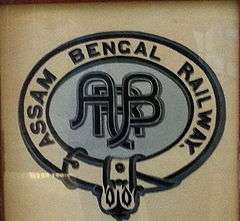Assam Bengal Railway
 | |
| Industry | Railways |
|---|---|
| Founded | 1892 |
| Defunct | 1942 |
| Headquarters | Chittagong, British India |
Area served | Assam and Bengal |
| Services | Rail transport |
The Assam Bengal Railway was one of the pioneering railway companies in British India. Headquartered in Chittagong, it functioned from 1892 to 1942.[1] The origin of the Assam and Bengal Railway, a railway system operated in India between 1942 and 1947, lies in the Assam Bengal Railway, which was made in the 1880s.[2][3][4]
History
Assam Bengal Railway was incorporated in 1892 to serve British-owned tea plantations in Assam.[5] In 1942 the management of Assam Bengal Railway was transferred to the Govt of India. It was amalgamated with the state managed Eastern Bengal Railway and designated as Assam Bengal Railway .[5]
On 1 January 1942 the Assam Bengal Railway combined with the Eastern Bengal Railway to form the Bengal and Assam Railway.[2][6][7] At time of the independence of India in 1947, Bengal-Assam Railway was split up and the portion of the system, about 2,603.92 km long which fell within the boundary of erstwhile East Pakistan was named as Eastern Bengal Railway, the control remaining with the central Government of Pakistan. Later, with the effect from 1 February 1961, Eastern Bengal Railway was renamed as Pakistan Railway.[6]
Successors
With the partition of India in 1947, portions of the Bengal Assam Railway which lay in Assam and the Indian part of North Bengal became Assam Railway. North Eastern Railway was formed in 1952 by amalgamating Assam Railway with Oudh Tirhut Railway and Fatehgarh district of Bombay, Baroda and Central India Railway. Northeast Fronter Railway was carved out of North Eastern Railway in 1958.[5][8]
The portion of the system which fell within the boundary of erstwhile East Pakistan was named as Eastern Bengal Railway. On 1 February 1961, Eastern Bengal Railway was renamed as Pakistan Railway and in 1962 it became Pakistan Eastern Railway.[9] With the emergence of Bangladesh, it became Bangladesh Railway.[10]
After the independence of Pakistan on 15 August 1947 the broad-gauge portion of the Bengal-Assam Railway, lying in India was added to the East Indian Railway and the metre-gauge portion became the Assam Railway,[11] with its headquarters at Pandu. On 14 April 1952, the 2857 km long Assam Railway and the Oudh and Tirhut Railway were amalgamated to form one of the six newly carved zones of the Indian Railways: the North Eastern Railway (India).[12][13] On the same day, the reorganized Sealdah division of the erstwhile Bengal Assam Railway (which was added to the East Indian Railway earlier) was amalgamated with the Eastern Railway.[14]
Lines
Assam Bengal Railway started construction of a railway track on the eastern side of Bengal in 1891. A 150 kilometres (93 mi) track between Chittagong and Comilla was opened to traffic in 1895. The Comilla-Akhaura-Kalaura-Badarpur section was opened in 1896–1898 and finally extended to Lumding in 1903.[10][15][16] The Assam Bengal Railway constructed a branch line to Guwahati, connecting the city to the eastern line in 1900. The line was extended to Tinsukia in 1902 and it was also connected to Dibru-Sadiya Railway in 1903.[5]
See also
References
- ↑ "Archived copy". Archived from the original on 26 September 2013. Retrieved 2013-09-13.
- 1 2 Mukherjee, Hena (2012). "Assam Bengal Railway". In Islam, Sirajul; Jamal, Ahmed A. Banglapedia: National Encyclopedia of Bangladesh (Second ed.). Asiatic Society of Bangladesh.
- ↑ Mukherjee, Hena (2012). "Eastern Bengal Railway". In Islam, Sirajul; Jamal, Ahmed A. Banglapedia: National Encyclopedia of Bangladesh (Second ed.). Asiatic Society of Bangladesh.
- ↑ Islam, Sirajul (2012). "East Indian Railway". In Islam, Sirajul; Jamal, Ahmed A. Banglapedia: National Encyclopedia of Bangladesh (Second ed.). Asiatic Society of Bangladesh.
- 1 2 3 4 R.P. Saxena. "Indian Railway History timeline". Retrieved 2012-02-24.
- 1 2 History, Bangladesh Railway, People's Republic of Bangladesh, Retrieved: 2007-01-11
- ↑ Rao, M.A. (1988). Indian Railways, New Delhi: National Book Trust, p.37
- ↑ "History". Northeast Frontier Railway. Retrieved 2012-02-24.
- ↑ "History". Bangladesh Railways. Retrieved 2012-02-24.
- 1 2 Fida, Quazi Abul (2012). "Railway". In Islam, Sirajul; Jamal, Ahmed A. Banglapedia: National Encyclopedia of Bangladesh (Second ed.). Asiatic Society of Bangladesh.
- ↑ Rao, M.A. (1988). Indian Railways, New Delhi: National Book Trust, p.39
- ↑ "Chapter 1 - Evolution of Indian Railways-Historical Background". Ministry of Railways, India website. Archived from the original on 1 June 2009.
- ↑ Rao, M.A. (1988). Indian Railways, New Delhi: National Book Trust, pp.42-3
- ↑ "Sealdah division-Engineering details". The Eastern Railway, Sealdah division.
- ↑ "Report on the administration of North East India (1921-22)". p. 46. Google Books/ Mttal Publishers Distributors. Retrieved 2011-12-16.
- ↑ S.N. Singh; Amarendra Narain; Purnendu Kumar. "Socio Economic and Political Problems of Tea Garden Workers: A Study of Assam, Published 2006, ISBN 81-8324-098-4". p. 105. Mittal Publications, New Delhi. Retrieved 2011-12-16.